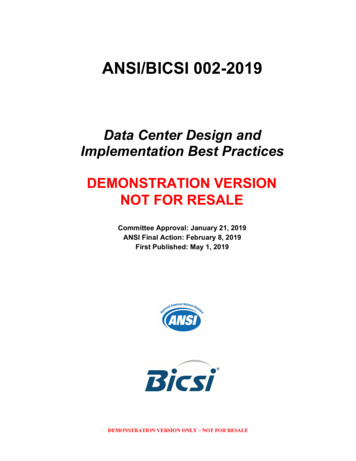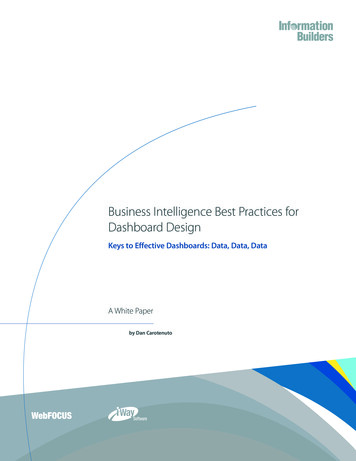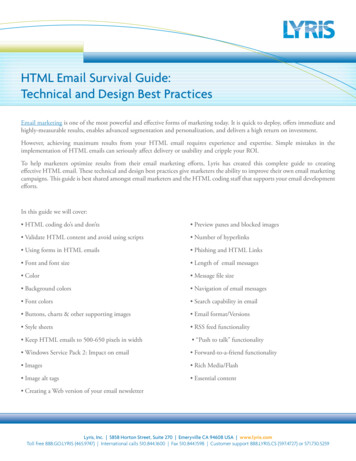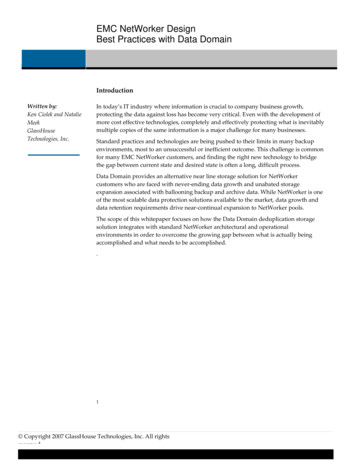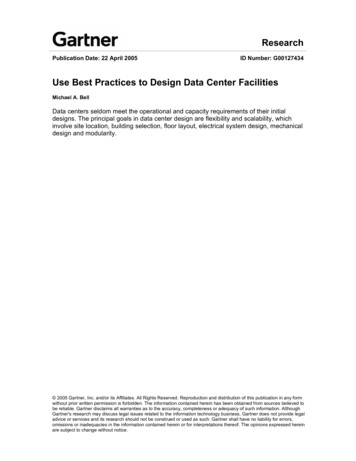
Transcription
ResearchPublication Date: 22 April 2005ID Number: G00127434Use Best Practices to Design Data Center FacilitiesMichael A. BellData centers seldom meet the operational and capacity requirements of their initialdesigns. The principal goals in data center design are flexibility and scalability, whichinvolve site location, building selection, floor layout, electrical system design, mechanicaldesign and modularity. 2005 Gartner, Inc. and/or its Affiliates. All Rights Reserved. Reproduction and distribution of this publication in any formwithout prior written permission is forbidden. The information contained herein has been obtained from sources believed tobe reliable. Gartner disclaims all warranties as to the accuracy, completeness or adequacy of such information. AlthoughGartner's research may discuss legal issues related to the information technology business, Gartner does not provide legaladvice or services and its research should not be construed or used as such. Gartner shall have no liability for errors,omissions or inadequacies in the information contained herein or for interpretations thereof. The opinions expressed hereinare subject to change without notice.
TABLE OF CONTENTS1.0 Introduction . 41.1 Density vs. Capacity . 51.2 Rack Layout. 61.3 Rack Units . 72.0 Design Criteria . 82.1 Critical Building Systems . 92.2 Planning and Designing. 102.3 Location . 112.4 Site. 122.5 Architecture . 132.6 Power Distribution . 142.7 Power Supply . 152.8 Mechanical Systems. 162.9 Raised-Access Floor . 172.10 Fire Detection and Suppression . 183.0 Data Center Construction Costs — Tier 2. 193.1 Data Center Construction Costs — Tier 3. 204.0 Data Center Facilities Management Options:. 225.0 Conclusion . 23Appendix A. Conference Poll Results . 23Appendix B. Acronym Key. 25LIST OF FIGURESFigure 1. The First Rule of Data Center Facilities: Design for Flexibility and Scalability . 5Figure 2. The Density vs. Capacity Debate. 6Figure 3. Rack Layout Resulting Power Demands. 7Figure 4. Use Rack Unit — The Primary Planning Factor. 8Figure 5. Design Criteria: Scope and Redundancy . 9Figure 6. Critical Building Systems. 10Figure 7. Engineering Plan and Space Design . 11Figure 8. Location Selection . 12Figure 9. Site and Building Selection Criteria. 13Figure 10. Site and Building Selection Criteria (Continued). 14Figure 11. Power Distribution . 15Figure 12. UPS/Backup Generators . 16Figure 13. Mechanical Systems . 17Figure 14. Raised Floors . 18Publication Date: 22 April 2005/ID Number: G00127434 2005 Gartner, Inc. and/or its Affiliates. All Rights Reserved.Page 2 of 26
Figure 15. Fire Detection and Suppression. 19Figure 16. Data Center Construction Costs —Tier 2. 20Figure 17. Construction Costs — Tier 3 . 21Figure 18. Conference Poll Results: Facility Problems . 24Figure 19. Conference Poll Results: Tier Levels . 24Figure 20. Conference Poll Results: Power Rating . 25Publication Date: 22 April 2005/ID Number: G00127434 2005 Gartner, Inc. and/or its Affiliates. All Rights Reserved.Page 3 of 26
ANALYSISManagement SummaryData center facilities rarely achieve the operational and capacity requirements specified in theirinitial designs. The advent of new technologies, such as blade servers, that require substantialincremental power and cooling capacity; the pressure to consolidate multiple data centers intofewer locations; the need for incremental space; changes in operational procedures; and potentialchanges in safety and security regulations converge to impose constant facilities changes on themodern data center.The overarching rule in data center facilities is to design for flexibility and scalability. This ruleembraces several key principles in the site location, building selection, floor layout, electricalsystem design, mechanical design, and the concept of modularity that enables the data centerfacility to change and adapt as needed, with minimum renovation and change to basic buildingsystems.This research delves into specific guidelines on achieving a high level of flexibility and scalabilityin the data center. These best practices address site location, building selection, and principles inthe design and provisioning of critical facilities systems. In doing so, it examines the followingClient Issues: What is the impact of new hardware technologies on the infrastructure of data centerfacilities? What are the critical design considerations and best practices in the site selection anddesign of data center facilities? What cost elements are associated with different levels of data center reliability and faulttolerance? How should the management of data center facilities be organized?1.0 IntroductionStrategic Planning Assumption: Through 2009, 70 percent of data center facilities will fail to meetoperational and capacity requirements without some level of renovation, expansion or relocation(0.7 probability).The key to a successful data center facility — one that is sustainable in the long term — is toconsider it as a receptacle for equipment and operations, as well as an integrated system, inwhich each component must be considered in the context of flexibility and scalability (see Figure1).Publication Date: 22 April 2005/ID Number: G00127434 2005 Gartner, Inc. and/or its Affiliates. All Rights Reserved.Page 4 of 26
Figure 1. The First Rule of Data Center Facilities: Design for Flexibility and ScalabilityMurphy's Law: "What can go wrong — will!"Bell's Law: "Murphy was an optimist."New equipmentConsolidations and expansionsNew redundancy requirementsIncremental power requirementsForcesofChangeIncremental cooling demandsConstrained floor spaceNew safety and security regulationsChanges in operational proceduresChanges in missionCost pressuresSource: Gartner Research (April 2005)Action Item: Stress flexibility and scalability in all aspects of the data center facility, includinglocation, building selection, space layout and building systems design.1.1 Density vs. CapacityTactical Guidelines: As a general rule, plan for the data center to scale from 50 watts to100 watts per square foot (that is, in a raised floor area); increase capacity on a modularbasis. Assess the trade-offs between space and power in the total cost of the new facility.Provide additional space between racks for air circulation.Client Issue: What is the impact of new hardware technologies on the infrastructure ofdata center facilities?Evidence is growing that data centers are being over-designed for electrical capacity, because ofconcerns about meeting the incremental power and cooling demands of modern serverequipment (such as blade servers). Sufficient capacity should be delivered relative to patchpanels, conduits and intermediate distribution feeds. Special attention should be focused onequipment densities relative to initial and longer-term electrical power capacities. Electricalcapacity ranging from 30 watts to 70 watts per square foot for computer equipment is typicallyrequired. However, additional power is required for air conditioning, humidification, lighting, anduninterruptible power supply (UPS) and transformer losses. This additional demand could addone to one-and-a-half times more wattage to the electrical load, depending on equipment spacingand air-handling efficiencies. In Figure 2, heat densities are expressed in watts per square foot forthe equipment footprint. Actual watts per square foot over the raised floor would be substantiallyless when aisle space — and other space — is included in the calculation.Publication Date: 22 April 2005/ID Number: G00127434 2005 Gartner, Inc. and/or its Affiliates. All Rights Reserved.Page 5 of 26
Figure 2. The Density vs. Capacity Debate10,000100,000Product Heat Density Trends Chart8,00080,0006,00060,000Space/Power Trade-offTotal costPower 0Heat Loadper800ProductFootprint600(watts/ft.2 )Space20,000Units of Measure10,000Servers and DiskStorage Systems(1.8–2.2 m tall)8,0006,000400Heat (standalone)2002,0001,000100Tape 0062008 Focus on densityvs. capacity Provide ample clearancesbetween racks Provide expansion space Use actual connectedload, not equipmentnameplate load Be mindful of differentmeasures Plan to scale up modularly2010Year of Product AnnouncementSource: The Uptime Institute and the Thermal Management Consortium, a collaborative effort of Amdahl, CiscoSystems, Compaq Computer, Cray, Dell, EMC, Hewlett-Packard, IBM, Intel, Lucent Technologies, Motorola, Nokia,Nortel Networks, Sun Microsystems and UnisysGartner recommends that the data center be designed to scale from 50 watts to 100 watts persquare foot for raised floor areas. Incremental capacity can be added on a modular basis.Action Item: Focus on density vs. capacity; consider more-liberal spacing between racks tomitigate heat gain by improving airflow.1.2 Rack LayoutTactical Guideline: Distribute high-density racks throughout the layout to mitigate hotspots; use spot cooling as necessary.Modern blade servers can be packed into a single-rack enclosure, resulting in power demands of18 to 20 kilowatts per rack. The primary issue with dense-packing the layout with high-capacityPublication Date: 22 April 2005/ID Number: G00127434 2005 Gartner, Inc. and/or its Affiliates. All Rights Reserved.Page 6 of 26
servers is that, although it is efficient from a space standpoint, it creates serious heat problemsrequiring incremental cooling, as well as significant incremental electrical costs (see Figure 3).Figure 3. Rack Layout Resulting Power DemandsAlternative 1Alternative 210 KW Rack2 KW RackExpansion spaceExpansion space10 KW per rack166 watts/SF4.2 KW per rack70 watts/SFSource: Gartner Research (April 2005)Alternatives to a dense-pack approach would involve blending high and low density throughoutthe layout. In Alternative 1 in Figure 3, the racks are fully packed with high-density blade servers,which require 166 watts per square foot in electrical capacity. In Alternative 2, a blend of highand low-density rack configuration results in 70 watts per square foot. This enables expansion ofup
Use Best Practices to Design Data Center Facilities Michael A. Bell Data centers seldom meet the operational and capacity requirements of their initial designs. The principal goals in data center design are flexibility and scalability, which involve site location, building selection, floor layout, electrical system design, mechanical




